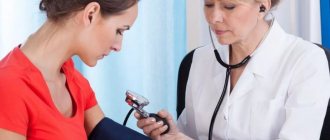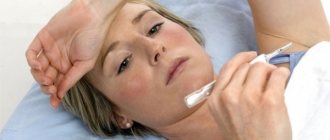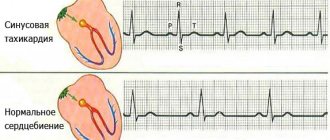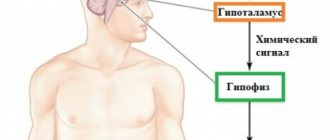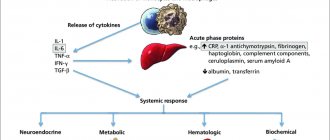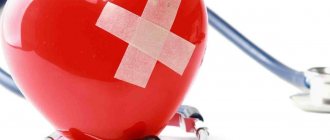Causes in patients aged 30, 40 and after 50 years
Tachycardia at 30 years of age often occurs due to hormonal imbalance. This is facilitated by fluctuations in the concentrations of thyroxine, triiodothyronine and calcitonin.
The most common reason for the development of pathology in women over the age of 40 is a malfunction of the thyroid gland, namely its hyperfunction. This disorder is not dangerous and can be quickly treated.
At the age of 50, women experience menopause . Many changes occur in the body that can contribute to the development of a pathological condition.
Failures of heart contractions occur against the background of the following clinical situations:
- heart pathologies;
- increased blood pressure;
- decreased elasticity of blood vessels.
Heart rate depends on the functioning of the thyroid gland. Other dissolved causes include:
- congenital heart disease;
- excessive coffee consumption;
- endocrine disorders;
- being overweight;
- alcohol consumption;
- undergoing chemotherapy.
Depending on the causes of the disease, therapy is prescribed. It should be aimed not only at improving the general condition of the patient, but also at eliminating the factor that provoked it.
Drugs
Sinus tachycardia occurs for various reasons, which must be eliminated first. In case of arrhythmia caused by an acute experience of even banal everyday conflicts, one cannot do without a course of taking antipsychotics and (or) tranquilizers.
Benzodiazepine derivatives have proven themselves especially well:
- • Alprazolam;
- • Diazepam;
- • Clobazam;
- • Midazolam;
- • Lorazepam;
- • Relanium.
If the pathology has developed against the background of severe, protracted depression, then antidepressants, for example, Fluoxetine, are included in the treatment regimen. To strengthen the nervous system, Noopept, Magnelis, Combilipen, Neurobion, Milgamma, Pentovit and balanced vitamin-mineral complexes are indicated.
Mild forms of neurosis can be treated with gentle sedatives and sedatives - Tenoten, Novo-Passit, peony tinctures, motherwort valerian.
To restore heart function, stop surges in blood pressure, and improve myocardial conductivity, patients are prescribed drugs from the following clinical and pharmacological groups:
- • calcium channel blockers . They exhibit antiarrhythmic, hypotensive and antianginal activity by blocking “slow” calcium channels, which are located in the heart muscle, conduction system and blood vessels. Verapamil and Diltiazem are most often used in the treatment of sinus tachycardia;
- • cardiac glycosides . Used when calcium channel blockers are ineffective, they increase the contractility of the heart muscle by increasing the concentration of calcium ions in cardiomyocytes. The most popular representative of cardiac glycosides is Digoxin in the form of tablets or solution for parenteral administration;
- • antiarrhythmic drugs . They have a direct membrane-stabilizing and local anesthetic effect on cardiac muscle cells. At the same time, they exhibit β-adrenergic blocking activity and block membrane sodium channels. To treat this arrhythmia, Propafenone and its analogues - Ritmonorm, Propanorm - are used;
- • thyreostatics . They are used to reduce the increased activity of the thyroid gland and regulate its production of hormones. Mercazolil is considered the safest thyreostat for heart disease;
- • preparations with iron . To eliminate the anemia that often accompanies sinus tachycardia, Ferrum-Lek, Ferroplex, and Totema are used. The products replenish iron reserves in the body, which has a beneficial effect on hematopoietic processes.
Nimesulide or Nimesil, which is better?
But the first choice drugs in the treatment of sinus tachycardia are always beta-blockers. A course of taking Bisoprolol, Metoprolol, Nebivalol and their structural analogues leads to a decrease in the sensitivity of the myocardium to provoking factors.
The transmission of nerve impulses to the central nervous system also slows down. Beta blockers are well tolerated even in the presence of severe cardiac pathologies and do not cause addiction or withdrawal symptoms.
By what signs can you recognize it?
The main symptom of tachycardia is a rapid pulse. The patient also exhibits a number of additional symptoms:
- fast fatiguability;
- dizziness;
- pain in the chest area;
- state of suffocation;
- periodic darkening of the eyes;
- faintness or loss of consciousness.
Sometimes vegetative symptoms . These include:
- shortness of breath;
- nausea;
- vomiting;
- constant feeling of anxiety and panic;
- problems with breathing;
- fear of dying.
Women experience irregularities in the menstrual cycle, mood swings and sudden weight loss. If the first symptoms of the disease occur, you should consult a doctor.
How to spot a problem at an early stage?
To avoid complications, it is important to notice the problem in its infancy.
Adults often tend to ignore obvious symptoms of deterioration of their condition, because they are busy with business and have no time to go to the doctor.
People aged 50 are especially guilty of this - they realize that they are getting old, but stubbornly deny it.
Most often, the symptoms of tachycardia in women and men look the same. The reasons that caused them may differ, but these differences are also insignificant. In women, most diseases begin to manifest themselves during menopause - this is when the body actively ages, and many diseases are born. Therefore, after 50 years, you should pay attention to the following signs:
- a person gets tired too quickly,
there is often a feeling of weakness,- pain, discomfort in the heart,
- anxiety, unreasonable worry,
- recurring dizziness,
- fainting,
- fast heartbeat rhythm that can be felt without measuring instruments.
There are many cases where the signs of tachycardia were so weak that they could not be noticed. Women have an additional difficulty in diagnosing tachycardia due to the fact that all these symptoms at the age of about 50 years can be explained by the onset of menopause. Therefore, women should be especially careful and consult a doctor.
During menopause, women often complain of heart problems. Sometimes this is not dangerous when the symptoms of the disease are caused by a decrease in estrogen in the woman’s body. Since estrogen affects the autonomic nervous system and heart activity, the causes of tachycardia after a decrease in its amount are understandable.
A rapid heartbeat during menopause is normal. But you should make sure that changes in the rhythm of heart contractions are not associated with anything else. Only after a thorough diagnosis can you stop worrying.
Woman, 47 years old. She consulted a doctor with complaints of frequent dizziness and fainting. Periodically, she experiences strong palpitations and heart pain, and general weakness. Diagnosis: tachycardia associated with the onset of menopause. For treatment, motherwort tincture and anaprilin were prescribed in case of attacks.
Puberty (before and during menstruation)
A large number of changes occur in the female body during puberty. A situation often arises when the blood vessels cannot keep up with the growth of the heart muscle. As a result, disruptions in heart contractions are observed.
The main reasons for the development of tachycardia in adolescence:
- lack of a stable menstrual cycle;
- weak muscles;
- asthenic body constitution.
The emotional state of a teenage girl is of great importance.
During this period, quite sudden mood swings may occur. A rapid heartbeat can appear at any time and also quickly stabilize. Attacks of tachycardia in girls at puberty are accompanied by darkening of the eyes, dizziness or loss of consciousness. Such symptoms indicate the need to undergo examination by a qualified specialist.
What is tachycardia?
To better understand the mechanism of the appearance of a rapid pulse, doctors distinguish 2 forms of deviations from the norm:
- Physiological – associated with physical activity. For example, you are jogging or walking up to the 9th floor.
- Pathological – formed due to existing diseases, not necessarily related to the cardiovascular system. These may be nervous disorders and shocks, alcohol intoxication, disruptions in the endocrine system.
When a patient first consults a cardiologist, the doctor initially determines the form of tachycardia. The course of a woman’s illness at this point can be either chronic or paroxysmal.
The paroxysmal type of rapid heartbeat is easy to distinguish by the clear time boundaries of the attack - the patient herself determines when it begins and ends, which cannot be said about sinus tachycardia.
In some women, tachycardia may be congenital and pass almost unnoticed. Other patients feel obvious discomfort and worry, which makes the pulse quicken even more, and the attack becomes even more pronounced.
To record a rapid heartbeat, you do not need special equipment - just feel the pulse on your wrist or on the side of your neck and count it in a minute.
Treatment of tachycardia after eating
During pregnancy
Tachycardia in pregnant women is observed quite often. The cause of the development of the pathological condition may be:
- deficiency of nutrients;
- significant weight gain;
- hypertension;
- anemia;
- fetal growth;
- increased load on the heart;
- gestosis.
During growth, the fetus constantly displaces the woman's internal organs, which negatively affects the heart rate. Most episodes of palpitations are not dangerous for the expectant mother or fetus. Therefore, it is safe to give birth with such a disorder. However, it is imperative to consult a doctor, since during pregnancy there is a high risk of exacerbation of chronic diseases.
If there are no organic reasons for the development of the deviation, then the doctor simply recommends maintaining a rest regime and limiting physical activity.
Main causes of high heart rate
In older people, the heart rate tends to slow down. A rapid heartbeat is most often a sign of a disease or pathological condition.
Possible “cardiac” causes of tachycardia:
- IHD, exertional and unstable angina;
- hypertension;
- post-infarction cardiosclerosis;
- heart failure;
- heart defects;
- atrial fibrillation (atrial fibrillation);
- decrease in blood pressure.
Of the “non-cardiac” causes, tachycardia in the elderly is usually caused by:
- anemia;
- bronchitis and other lung diseases;
- excessive physical overload;
- exposure to heat;
- unexpected stress, moving, hospitalization;
- smoking;
- feverish conditions, colds;
- side effects of medications;
- excess thyroid hormones (hyperthyroidism);
- chronic kidney disease and diabetes.
Menopause
During menopause, the body is greatly affected, as all organs and systems begin to work differently. Often women at this age experience a deterioration in their general health.
Tachycardia during menopause occurs against the background of the following changes:
- blood thickening;
- decreased elasticity of blood vessels;
- emotional instability;
- weight gain;
- passive lifestyle;
- presence of bad habits.
During menopause, large amounts of cholesterol accumulate in the blood. Its composition begins to change, which leads to an increase in viscosity. The process of pumping blood becomes more labor-intensive, so the heart must work more actively.
With age, blood vessels lose their elasticity. They become more fragile, and cholesterol plaques form on their walls. As a result of such changes, blood pressure levels increase.
A woman during menopause is prone to frequent mood swings, increased anxiety and nervousness. All these factors have a negative impact on the condition of the heart.
With the onset of menostasis, the estrogen deficiency begins to be compensated by the fat layer.
Excess weight has a bad effect on the cardiovascular system, and as a result, patients experience tachycardia. Important! The patient's condition is aggravated by a passive lifestyle and bad habits.
About sinus tachycardia and its types
Sinus tachycardia is a type of arrhythmia characterized by increased activity of the sinus node. The sinoarterial node is the main source that generates electrical impulses that set the normal heart rhythm. With sinus tachycardia, the number of heart contractions exceeds 100 beats per minute.
The characteristic symptoms of this disease cannot be ignored.
During an attack, a person is worried about:
- • Rapid heartbeat, feeling as if there is a lump in the throat.
- • Severe weakness, aching pain in the temples or the back of the head, severe dizziness.
- • Shortness of breath even in the absence of physical activity.
- • Constrictive pain in the left side of the chest. The pain can radiate to the arm, shoulder, or scapula area.
- • Panic, fear for your life.
- • Cold sweat.
- • Decreased performance.
- • Poor tolerance of even minor physical activity.
In medicine, the following types of sinus tachycardia are distinguished:
- • Physiological . This type of heart rhythm disorder can occur in people who do not have any health problems. Physiological tachycardia is often diagnosed in young children under 7 years of age, adolescents during puberty, and people whose lives often involve increased physical activity.
- • Pathological . It is a consequence of the progression of diseases of the cardiovascular system in the body, as well as pathologies of other internal organs. Pathological sinus tachycardia is a dangerous disorder that requires timely detection and treatment. Otherwise, life-threatening complications cannot be avoided.
Troxerutin and Troxevasin, what is the difference
According to the nature of the course, the following subtypes of sinus tachycardia are distinguished:
- • adequate;
- • inadequate.
Inappropriate tachycardia is a rare, little-studied pathology. Heart rhythm disturbances during an attack do not depend on the load, the use of provoking medications, and can persist in a state of absolute rest.
The main symptoms of tachycardia of this type:
- • Strong heartbeat – up to 220 beats per minute.
- • Acute lack of air.
- • Blurred consciousness.
Diagnosis and treatment
There are a large number of methods that allow you to diagnose tachycardia and determine the cause of its occurrence. The doctor can perform part of the diagnosis during the initial examination. A more thorough examination is carried out by a cardiologist.
If the rapid heart rate occurs due to an infectious disease, then a thorough study of the heart rhythm is not required.
Diagnostic procedures:
- visual examination of the patient;
- auscultation of the heart;
- electrocardiography;
- heart rate measurement;
- phonocardiography.
If tachycardia has physiological causes, then it does not require treatment. Normal indicators are restored on their own and in a fairly short time.
Separate therapy for tachycardia is not provided if it is a symptom of one of the following diseases:
- large blood loss;
- anemia;
- state of shock;
- Congenital heart defect;
- infectious diseases.
In this case, the underlying disease is treated, and sinus rhythm is restored on its own. Elimination of this pathological condition involves:
- taking medications;
- surgical intervention;
- electropulse therapy;
- use of folk remedies.
In most cases, therapy is carried out on an outpatient basis. However, sometimes urgent hospitalization is required.
The main directions in the treatment of deviations:
- slowing down the rate of contraction of the heart muscle;
- prevention of tachycardia attacks;
- eliminating the cause of the disease.
Simple methods such as changing your body position or using a cold compress can be used to slow your heart rate. In which cases, Flecainide or Propafenone is prescribed.
To prevent new attacks of tachycardia, beta blockers (Metaprolol, Bisoprolol, Atenolol) are used. If necessary, a course of calcium channel blockers is prescribed. At the same time, you need to take medications that will help prevent the formation of a blood clot.
Important! A prerequisite for effective treatment is impact on the cause of the disease.
Sinus tachycardia in children and adults
Sinus tachycardia in a child
Sinus tachycardia is detected in 40% of infants who are actually healthy, and this phenomenon is associated with vascular immaturity and rapid growth. In such cases, this disorder does not pose a danger and goes away on its own within 1 year of life, although children who have been diagnosed with this condition need constant medical supervision.
After the age of 12 months, the phenomenon is regarded as a symptom of some pathology.
The following conditions and diseases can provoke the development of sinus tachycardia in childhood:
- • dehydration;
- • oxygen starvation;
- • states of shock;
- • elevated temperature;
- • anemia;
- • pulmonary edema;
- • hypercalcemia;
- • hyperthyroidism.
What can you drink instead of Bisoprolol, analogues and substitutes for the drug without side effects
The main symptoms of the disorder are attacks of rapid pulse, which may be accompanied by dizziness, a feeling of pressure in the chest and fainting.
The condition is assessed as dangerous if the patient has pathologies of the heart and blood vessels, as well as if the attack lasts more than 5 minutes and causes fainting. In this case, an urgent visit to a doctor is required and a full examination with further prescription of therapy is required.
Sinus tachycardia in adolescents
In adolescence, the disease is common, which is also provoked by rapid growth and serious hormonal changes. The blood vessels of adolescents are not yet mature enough to keep up with these changes in the body, which leads to an increased heart rate.
In some cases, after the end of puberty, the problem goes away, but if it is provoked by any disease, then without treatment it continues into adulthood.
The pathological causes of sinus tachycardia in adolescents are:
- • endocrine disorders;
- • vegetative-vascular dystonia;
- • anemia;
- • hypertrophy of the heart muscle.
Often this form of arrhythmia is asymptomatic and is detected accidentally during a routine examination. This indicates that the teenager has no pathologies and the condition is associated with changes and a “hormonal storm.” At the same time, if you do not pay attention to the presence of tachycardia, there is a possibility that vegetative-vascular dystonia or heart failure will form.
Because of this, when a violation is detected, it is necessary to follow medical recommendations, even in the absence of symptoms. If pathologies occur, then during an attack the teenager will complain of chest pain, headache, sweating, tremors in the limbs and shortness of breath.
Sinus tachycardia in adults
In adults, sinus tachycardia can be functional or pathological. The first appears in response to stress or emotional experiences, and its treatment is not required - it goes away on its own. With the second, which can be caused by many diseases of the heart muscle, as well as hypoxia, therapy is necessary.
The pathology is manifested by attacks, during which, in addition to a rapid pulse, the following are noted:
- • feeling of trembling in the heart;
- • heaviness in the chest;
- • shortness of breath;
- • pain in the heart area of a compressive nature, which lasts no more than 5 minutes;
- • dizziness;
- • severe, severe weakness;
- • fainting.
If the attacks are accompanied by prolonged pain and fainting, the patient needs urgent medical attention, as this may indicate a pre-infarction condition or the development of severe heart failure.
Sinus tachycardia in adulthood can be caused by taking a number of medications, such as certain hormonal agents, antidepressants and antihypertensives. In this case, it is necessary for the attending physician to replace the drug or adjust the dosage.
What causes increased heart rate in women?
Physiological tachycardia in women can be caused by:
- physical activity,
the onset of menopause (over 40 years of age),- stress, strong feelings and worries,
- sudden change in body position,
- excessive consumption of tonic or alcoholic drinks,
- changes in hormonal levels, which is typical for women during pregnancy,
- fever.
Manifestations of pathological tachycardia in women can occur due to:
- congenital or acquired diseases,
problems with the thyroid gland,- prolonged nervous overstrain, constant stressful situations,
- toxic effects of drugs in the treatment of serious diseases,
- metabolic diseases
- low blood pressure,
- anemia,
- bad habits.
It cannot be said that all these reasons cause tachycardia only in women, but among them there are those that are not typical for men.
Symptoms
The symptomatic picture of tachycardia depends on the form of its occurrence and the causes of its occurrence.
The appearance of tachycardia occurs suddenly and is not always associated with any provoking factors. In some cases, it is asymptomatic when the threshold of permissible heart rate values is slightly exceeded.
Depending on the etymology of tachycardia, it may be accompanied by characteristic symptoms:
- dizziness;
- dyspnea;
- persistent palpitations;
- hypoxia due to lack of air;
- pain and heaviness in the left side;
- increased sweating.
Symptoms may occur against the background of a general deterioration in health, the appearance of insomnia, decreased appetite, and increased fatigue.
The occurrence of tachycardia can occur after eating as a result of excessive consumption of foods that have a stimulating and irritating effect on the central nervous system, as well as containing caffeine. This could include drinks and chocolate.

